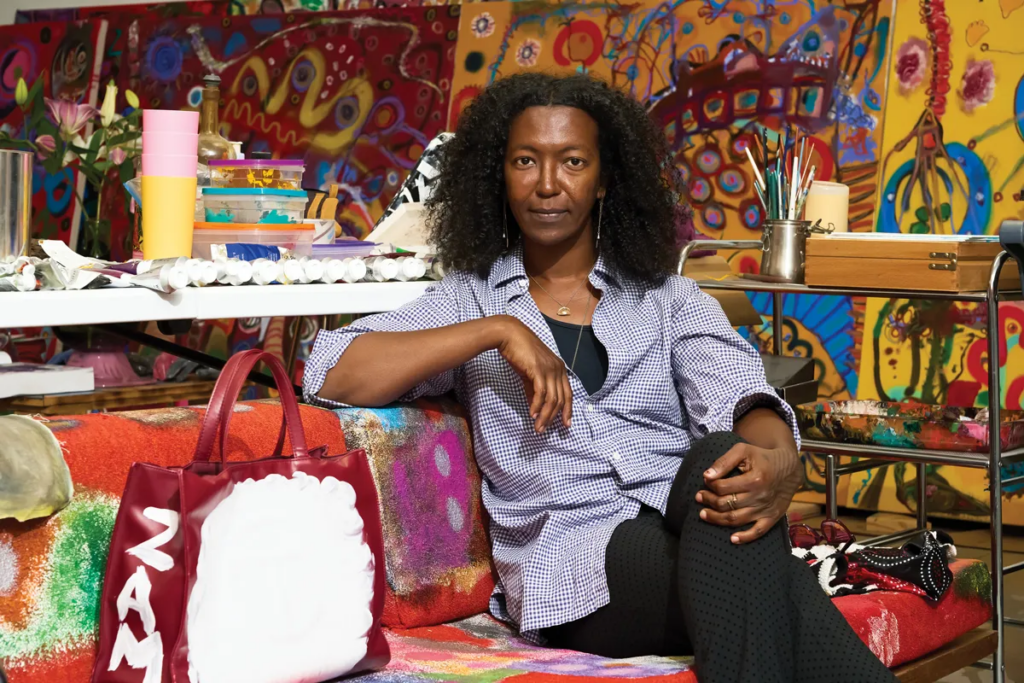
Toward the end of a 3-hour visit one afternoon this past August, Uman stood in a corner of her multiroom studio in Albany, New York, mixing oil paints in a small wooden box. She’d been working for weeks on an eight-foot-square canvas painted with a vibrant red background and a central white orb meant to denote a looming streetlamp. That day, she stepped forward and began adding raspberry globs of paint to the left side of the canvas.
“I might cover this up,” Uman said. “That’s sometimes how it goes. You work for weeks and weeks, and then you cover it up and you start again. I don’t mind that. I have done paintings with three paintings underneath, and the fourth one, over the rest, is the best one.”
She walked over to another canvas, the same brush in hand. The painting was still wet from a previous day’s work, so when Uman mixed her raspberry shade with the white already on that canvas, it turned a brilliant lilac. “I don’t think about it,” she said. “I just do it.”

Neither painting was headed to a forthcoming exhibition. She’d just had a show in the spring at Nicola Vassell Gallery in New York, but she wasn’t keen to stop working. During the summer months, she said, she maintains a strict 9-to-5 schedule three days a week. “It’s better than sitting and not doing anything at all,” she explained.
Although Uman’s schedule is rigid, her process is not. She often listens to house music as she works, in particular a radio station from New Orleans, though this isn’t a hard and fast rule—some series have also been produced to the sounds of Aretha Franklin and Janelle Monáe. And sometimes, with the help of an assistant, Uman rotates a canvas, allowing her to work on different areas of it. As she progresses, the canvas will return to its starting orientation, which she always remembers based on small details known only to her. (One of her paintings was hung upside-down a couple years ago because she didn’t indicate which way was up. “It looked great, but when I told them, they flipped it back, so it didn’t really make a difference,” she said.)
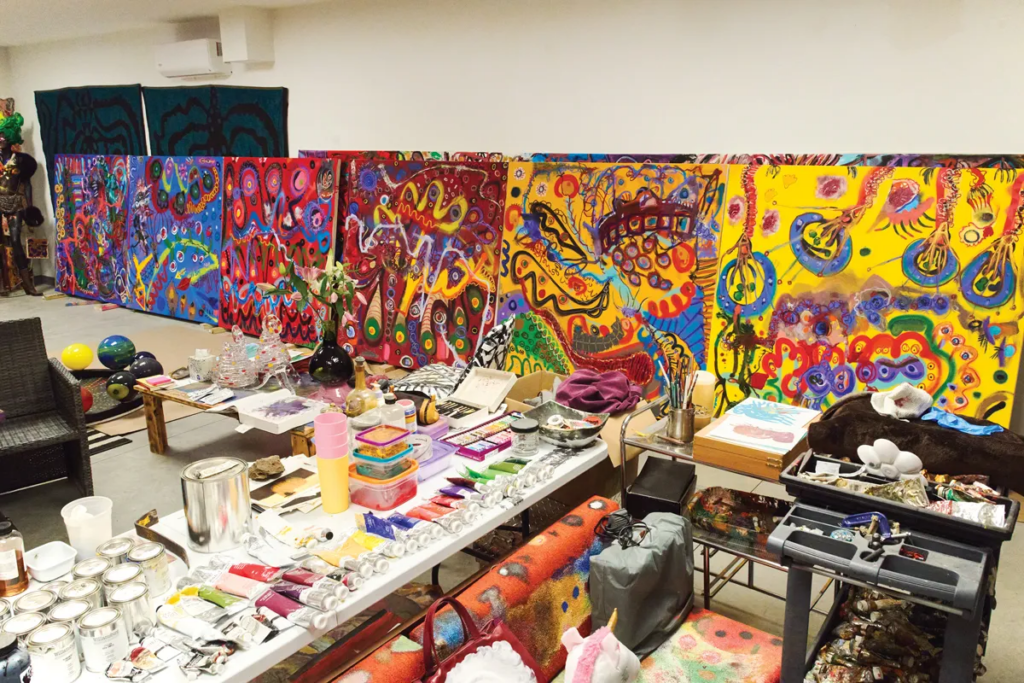
All around this room and the other spaces in Uman’s studio, dozens of canvases lie waiting. Some paintings in progress leaned against the walls, while others sat on wheeled wooden contraptions resembling supersize easels. She works primarily in a square format, ranging from 4 feet to 9 feet, though she has recently been experimenting with horizontal canvases stretching 12 feet wide. Some are primed in a monochrome that will ultimately be painted over, others are left raw, to be painted solely in black gesso. In total, there were more than 100 canvases in the 8,000-square-foot studio, which includes robust storage space and a woodshop for custom framing.
Part of the reason Uman has so many paintings around is that her output is relentless. She is honest about not every canvas being perfect. “I still have failures with paintings,” she said. “They don’t all come out good, but I’m able to think, Oh, I’ll make another one. When I make a beautiful painting so ugly, I say, ‘Oh my God, what did you do?’ And then I just say, ‘Keep going. You can turn this around.’ A lot of the time, it works for me.” She compared the act of finishing a painting to her childhood piano lessons and “that thrill of being able to complete a small verse in a song.”
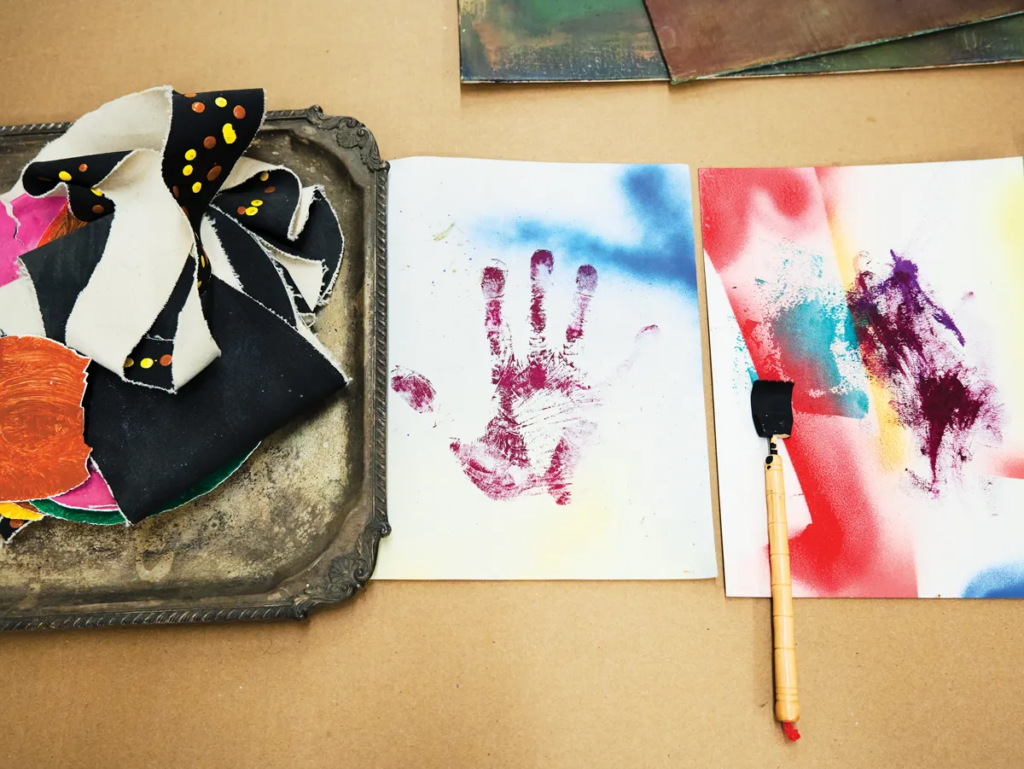
Though she doodled endlessly in her youth, Uman didn’t think she would be an artist until her 20s, which led her to move to New York. She was born in Somalia in 1980 and spent time in Kenya early on. Her family moved permanently to Kenya in 1989 at the outbreak of the Somali Civil War. She relocated to Denmark as a teenager to live with family there, and a few years later, visited an aunt in Vienna who took her to art museums. She has not returned to Africa since she left, partly for safety, because she is a trans woman: “It’s a fantasy to think that I would go back and have rights,” she said.
Shortly after moving to New York, Uman met Annatina Miescher, a psychiatrist at Bellevue Hospital who focused on art therapy. Uman considers Miescher a close friend and mentor, both in life and in art. “She was somebody who opened a channel that I couldn’t possibly have opened myself,” Uman said. “I think that it’s always been inside me, and I just didn’t know how to bring it out.”
Through Miescher, Uman met the late painter and critic Rene Ricard, an early champion of artists like Julian Schnabel and Jean-Michel Basquiat. Ricard encouraged her to keep at her painting. “He made me feel like I’m actually doing something,” she said.
During the early 2000s, Uman often sold her art on the street, usually in Union Square. It wasn’t until 2012, though, that she was included in group shows at the taste-making gallery Ramiken Crucible on the Lower East Side of New York and the Institute of Contemporary Arts, London. Then in 2015, she had her first solo show at the esteemed New York alternative space White Columns.

By that point she had already moved to Upstate New York, having relocated in 2010. Though her studio is not far from the Albany-Rensselaer Amtrak station, Uman lives about an hour-and-a-half west, near Cooperstown. “I’ve been here for a long time, before the pandemic-people came,” she said.
Her partner’s desire to live Upstate prompted the move. Financially, it made sense too. But Uman also said she’s not interested in the art world networking that often helps artists in major hubs achieve greater success. “I have everything I need. I’m not in that world, and the friends I have made over the years have come through mutual admiration and respect,” she said.
For this reason, and because Uman did not attend art school, some critics have labeled her a self-taught or outsider artist, which has historically been applied primarily to artists of color, Black artists in particular. “It’s a term,” she said sardonically. “I don’t care how people define me or my work. They can put me in a box and say, ‘You’re self-taught. You have to stay right in that corner. You’re not welcome in our club, our museum, our alumni group. You’re not welcome, period.’ That’s fine. I’m just doing my job. This is my work. I’m not even trying to be part of that club. But guess what? They found me and put my piece next to yours. We’re showing in the same place.”
She continued, “I know I’m not for everyone, and I’m definitely OK with that. I don’t want to please America or the world. I like that people don’t get my work. It makes me feel like I’m ahead of my time.”
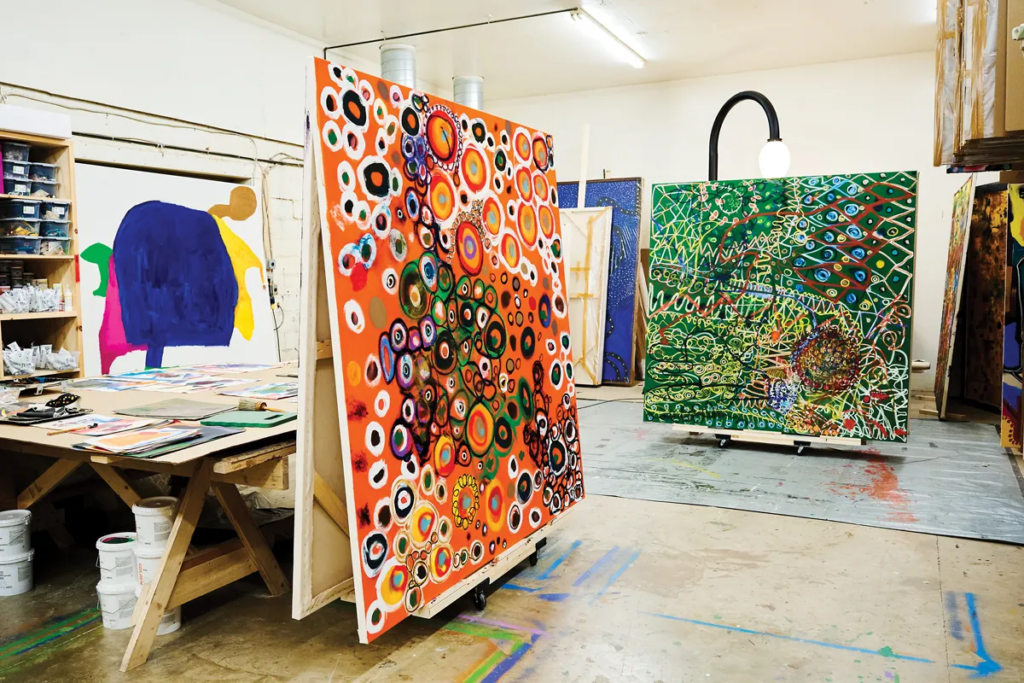
Nicola Vassell dedicated her gallery booth at the 2022 Independent art fair to an Uman solo presentation, greatly increasing the artist’s exposure and recognition, and attracting collectors like Rebecca and Martin Eisenberg. Uman tries not to let success affect her work. “It’s very different when you paint knowing that you’re going to sell,” she said. “I miss that feeling of not having any expectations. It’s different—2020 was this year of just not knowing where it’s going. The paintings were full of everything: naivete, sweetness, whimsy.”
She has, however, had to grow more decisive when it comes to finishing her paintings. “Years ago, I could sit with a canvas for a year or two, and then I could just put it away,” she said. “That’s a very pleasurable thing to have a canvas in your studio for a very long time. I find pleasure in even just adding one little, tiny dot of color.” (Most of her studio’s fixtures have been painted with grids of dots, from the doors and sinks to some of the couches.)
As her practice has evolved, her recent canvases have grown looser and more playful—bolder, even—but they never lose their ability to enthrall the viewer. They toe the line between abstraction and figuration: a mix of circles, triangles, spirals, waves, leaves, dots, and clouds, along with more humanistic traits, like eyes, hands, tails, mouths, and movement. “The ones that don’t look like self-portraits are self-portraits,” she said. “In a sense, everything I do is biographical on the canvas.”
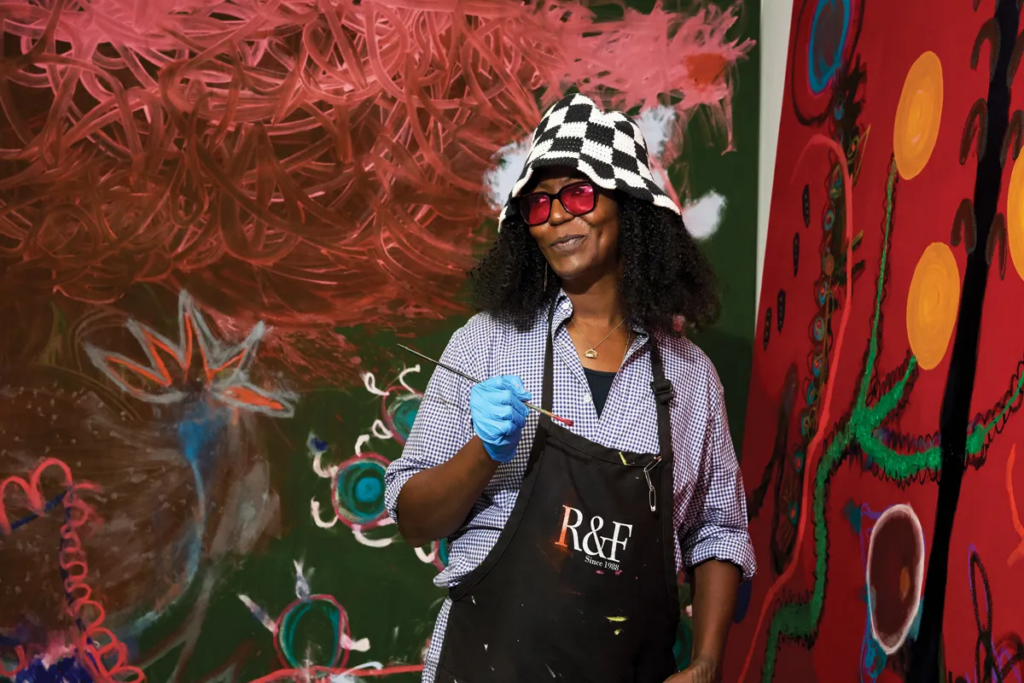
At a certain point, she decided that she wanted her canvases to mix both the figurative and the abstract: “I stopped fighting it, and now I’m just like, Let’s go, let’s do them both and not restrict myself,” she said. “It’s like playing music. I can play this instrument: use a brush, mix color. I have a good idea of what balances what through instinct, through years of practice, not through education.”
In her art, above all else, Uman prizes experimentation. She wants her practice to be in a state of “constant evolution” in which she can“push it even further.”
“I don’t like being stuck,” she said. “We have to experiment till death. I don’t want you to see me at 53, 10 years from now, and I’m still doing similar stuff.”
A version of this article appears in the 2023 ARTnews Top 200 Collectors issue.

